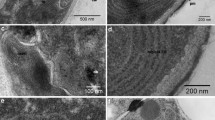Abstract
The process ofBeggiatoa trichome division was elucidated through phase-contrast microscopy and transmission and scanning electron microscopy. Trichome breakage and dispersion is accomplished by the formation of sacrificial cells (necridia) at various points within the trichome. Upon dying, the sacrificial cells lyse, dividing the trichome into two daughter trichomes. This process is identical with that found in many oscillatorian blue-green bacteria, but differs from the mechanism of trichome division in most of the other flexuous gliding bacteria. Cellular division within the trichome occurs by septation, involving the cytoplasmic membrane and the electron-dense L2 (peptidoglycan) layer. The outer envelope layers do not take part in division.
Similar content being viewed by others
Literature Cited
Brzin, B. 1966. Dependence of the cell morphology ofVitreoscilla on the temperature of incubation. Experientia22:1–5.
Burnham, J. C., Hageage, G. J., Jr. 1973. Effect of aldehyde fixatives on the adenosine phosphatases and ultrastructure ofVitreoscilla. Canadian Journal of Microbiology19:1059–1064.
Carr, N. G., Exell, G., Flynn, V., Hallaway, M., Talukdar, S. 1967. Minor quinones of some Myxophyceae. Archives of Biochemistry and Biophysies120:503–507.
Cataldi, M. S. 1940. Aislamiento deBeggiatoa alba en cultivo puro. Revista del Instituto Bacteriologico del Departmento Nacional de Higiene9:393–423.
Cohen, Y., Padan, E., Shilo, M. 1975. Facultative anoxygenic photosynthesis in the cyanobacteriumOscillatoria limnetica. Journal of Bacteriology123:855–861.
Costerton, J. W. F., Murray, R. G. E., Robinow, C. F. 1961. Observations on the motility and the structure ofVitreoscilla. Canadian Journal of Microbiology7:329–339.
Drawert, H., Metzner-Küster, I. 1958. Fluorescenz-und elektronmikroskopische Untersuchungen anBeggiatoa alba undThiothrix nivea. VI. Mitteilung der Reihe: Zellmorphologische und zellphysiologische Studien an Cyanophyceen. Archiv für Mikrobiologie31:422–434.
Drews, G. 1973. Fine structure and chemical composition of the cell envelopes, pp. 99–116 In: Carr, N. G., Whitton, B. A. (eds.), The biology of blue-green algae. Oxford, London, Edinburgh, Melbourne: Blackwell Scientific Publications.
Garlick, S., Oren, A., Padan, E. 1977. Occurrence of facultative anoxygenic photosynthesis among filamentous and unicellular cyanobacteria. Journal of Bacteriology129:623–629.
Jost, M. 1965. Die Ultrastruktur vonOscillatoria rubescens D. C. Archiv für Mikrobiologie50:211–245.
Kohl, F. G. 1903. Über die Organisation und Physiologie der Cyanophyceenzelle und die mitotische Teilung ihres Kernes, Jena: Gustav Fischer.
Kowallik, U., Pringsheim, E. G. 1966. The oxidation of hydrogen sulfide byBeggiatoa. American Journal of Botany53:801–806.
Lamont, H. C. 1969. Shear-oriented microfibrils in the mucilaginous investiments of two motile oscillatorian blue-green algae. Journal of Bacteriology97:350–361.
Lamont, H. C. 1969. Sacrificial cell death and trichome breakage in an oscillatorian blue-green alga: The role of murein. Archiv für Mikrobiologie69:237–259.
Leadbetter, E. R. 1974. Family Beggiatoaceae, pp. 112–116. In: Buchanan, R. E., Gibbons, N. E. (eds.) Bergey's manual of determinative bacteriology, 8th ed. Baltimore: Williams & Wilkins Co.
Luft, J. H. 1961. Improvements in epoxy resin embedding methods. Journal of Biophysical and Biochemical Cytology9:409–414.
Maier, S., Murray, R. G. E. 1965. The fine structure ofThioploca ingrica and a comparison withBeggiatoa. Canadian Journal of Microbiology11:645–655.
Metzner, I. 1955. Zellmorphologische und Zellphysiologische Studien an Cyanophyceen. II. Zur Chemie und zum Submikroskopischen Aufbau der Zellwände, Sheiden und Gallerten von Cyanophyceen. Archiv für Mikrobiologie22:45–77.
Poos, J. C., Turner, F. R., White, D., Simon, G. D., Bacon, K., Russell, C. T. 1972. Growth, cell division, and fragmentation in a species ofFlexibacter. Journal of Bacteriology112:1387–1395.
Pringsheim, E. G. 1949. The relationship between bacteria and Myxophyceae. Bacteriological Reviews13:47–98.
Pringsheim, E. G. 1951. The Vitreoscillaceae: A family of colourless, gliding filamentous organisms. Journal of General Microbiology5:124–149.
Pringsheim, E. G. 1964. Heterotrophism and species concepts inBeggiatoa. American Journal of Botany51:898–913.
Reichenbach, H., Golecki, J. R. 1975. The fine structure ofHerpetosiphon, and a note on the taxonomy of the genus. Archives of Microbiology102:281–291.
Reichenbach, H., Kleinig, H., Achenbach, H. 1974. The pigments ofFlexibacter elegans: Novel and chemosystematically useful compounds. Archives of Microbiology101:131–144.
Reynolds, E. S. 1963. The use of lead citrate at high pH as an electron opaque stain in electron microscopy. Journal of Cell Biology17:208–212.
Ridgeway, H. F., Wagner, R. M., Dawsey, W. T., Lewin, R. A. 1975. Fine structure of the cell envelope layers ofFlexibacter polymorphus. Canadian Journal of Microbiology21:1733–1750.
Strohl, W. R., Larkin, J. M. 1977. Enrichment, isolation, and enumeration ofBeggiatoa. Abstracts of the Annual Meeting of the American Society for Microbiology1977:242.
Tredway, J. V., Lee, J. D., Burton, S. D. 1977. Morphological evaluation of the ultrastructure of marine and freshwaterBeggiatoa species. Abstracts of the Annual Meeting of the American Society for Microbiology1977:240.
van Iykelenburg, C. 1977. On the morphology and ultrastructure of the cell wall ofSpirulina platensis. Antonie van Leeuwenhoek Journal of Serology and Microbiology43:89–99.
Vaucher, J. P. 1803. Histoire des conferves d'eau douce, contenant leurs différent modes de reproduction, et la description de leurs principales espèces. Geneva: J. J. Paschoud.
Watson, M. L. 1958. Staining of tissue sections for electron microscopy with heavy metals. II. Applications of solutions containing lead and barium. Journal of Biochemical and Biophysical Cytology4:475–479.
Author information
Authors and Affiliations
Rights and permissions
About this article
Cite this article
Strohl, W.R., Larkin, J.M. Cell division and trichome breakage in Beggiatoa . Current Microbiology 1, 151–155 (1978). https://doi.org/10.1007/BF02601668
Published:
Issue Date:
DOI: https://doi.org/10.1007/BF02601668




